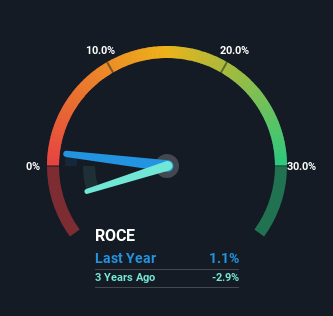- Hong Kong
- /
- Trade Distributors
- /
- SEHK:2326
New Provenance Everlasting Holdings' (HKG:2326) Returns On Capital Not Reflecting Well On The Business

If you're looking at a mature business that's past the growth phase, what are some of the underlying trends that pop up? Typically, we'll see the trend of both return on capital employed (ROCE) declining and this usually coincides with a decreasing amount of capital employed. This indicates the company is producing less profit from its investments and its total assets are decreasing. On that note, looking into New Provenance Everlasting Holdings (HKG:2326), we weren't too upbeat about how things were going.
Understanding Return On Capital Employed (ROCE)
For those that aren't sure what ROCE is, it measures the amount of pre-tax profits a company can generate from the capital employed in its business. The formula for this calculation on New Provenance Everlasting Holdings is:
Return on Capital Employed = Earnings Before Interest and Tax (EBIT) ÷ (Total Assets - Current Liabilities)
0.011 = HK$5.2m ÷ (HK$1.5b - HK$1.1b) (Based on the trailing twelve months to September 2023).
Thus, New Provenance Everlasting Holdings has an ROCE of 1.1%. Ultimately, that's a low return and it under-performs the Trade Distributors industry average of 4.5%.
Check out our latest analysis for New Provenance Everlasting Holdings

While the past is not representative of the future, it can be helpful to know how a company has performed historically, which is why we have this chart above. If you want to delve into the historical earnings, revenue and cash flow of New Provenance Everlasting Holdings, check out these free graphs here.
What The Trend Of ROCE Can Tell Us
We are a bit worried about the trend of returns on capital at New Provenance Everlasting Holdings. About five years ago, returns on capital were 33%, however they're now substantially lower than that as we saw above. And on the capital employed front, the business is utilizing roughly the same amount of capital as it was back then. Since returns are falling and the business has the same amount of assets employed, this can suggest it's a mature business that hasn't had much growth in the last five years. If these trends continue, we wouldn't expect New Provenance Everlasting Holdings to turn into a multi-bagger.
Another thing to note, New Provenance Everlasting Holdings has a high ratio of current liabilities to total assets of 70%. This effectively means that suppliers (or short-term creditors) are funding a large portion of the business, so just be aware that this can introduce some elements of risk. While it's not necessarily a bad thing, it can be beneficial if this ratio is lower.
The Bottom Line
In the end, the trend of lower returns on the same amount of capital isn't typically an indication that we're looking at a growth stock. It should come as no surprise then that the stock has fallen 69% over the last five years, so it looks like investors are recognizing these changes. With underlying trends that aren't great in these areas, we'd consider looking elsewhere.
One more thing, we've spotted 1 warning sign facing New Provenance Everlasting Holdings that you might find interesting.
If you want to search for solid companies with great earnings, check out this free list of companies with good balance sheets and impressive returns on equity.
Valuation is complex, but we're here to simplify it.
Discover if New Provenance Everlasting Holdings might be undervalued or overvalued with our detailed analysis, featuring fair value estimates, potential risks, dividends, insider trades, and its financial condition.
Access Free AnalysisHave feedback on this article? Concerned about the content? Get in touch with us directly. Alternatively, email editorial-team (at) simplywallst.com.
This article by Simply Wall St is general in nature. We provide commentary based on historical data and analyst forecasts only using an unbiased methodology and our articles are not intended to be financial advice. It does not constitute a recommendation to buy or sell any stock, and does not take account of your objectives, or your financial situation. We aim to bring you long-term focused analysis driven by fundamental data. Note that our analysis may not factor in the latest price-sensitive company announcements or qualitative material. Simply Wall St has no position in any stocks mentioned.
About SEHK:2326
New Provenance Everlasting Holdings
An investment holding company, sources and sells metal minerals and related industrial materials in Hong Kong and the People’s Republic of China.
Flawless balance sheet very low.


